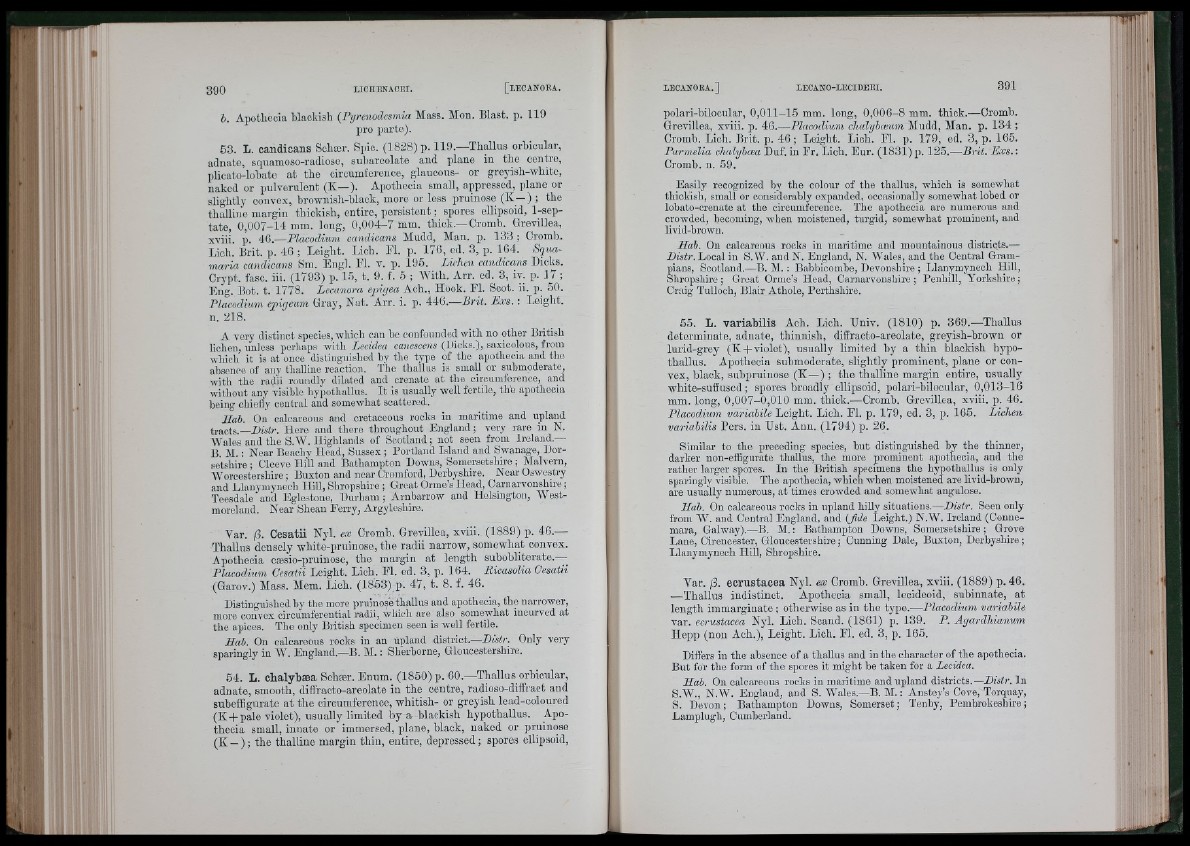
Il
b. Apothecia blackish (Pyrenodesmia Mass. Mon. Blast, p. 119
pro parto).
53. L. cand iean s Sohær. Spio. (1828) p. 119.—Thallus orbicular,
adnate, squamoso-radiose, subareolate aud plane in th e centre,
plicato-lübate a t the circumference, glaucous- or greyish-whito,
naked or pulverulent (K—). Apotliecia small, appressed, plane or
slightly convex, brownish-blaok, more or less pruinose (K —) ; the
thalline margin thiokish, entire, persistent ; sporos ellipsoid, 1-septate
, 0 ,0 0 7 -1 4m m . long, 0 ,0 0 4 -7 mm. thick.—Cromb. Grevillea,
xviii. p. 40.—Placodium candieans Mudd, Man. p. 133 ; Cromb.
Lioh. Brit. p. 40 ; Leight. Lioh. Fl. p. 176, cd. 3, p. 104. Squa-
maria candieans Sm. Engl. Fl. v. p. 195. Lichen candieans Dicks.
Crypt, faso. iii. (1793) p. 15, t. 9. f. 5 ; With . Arr. cd. 3, iv. p. 17 ;
Eng. Bot. t. 1778. Lecanora eqyiyea Ach., Hook. Fl. Soot. ii. p. 50.
Placodium epigeum Gray, Nat. Arr. i. p. 446.— B r it. Exs. ; Leight.
n. 218.
A verv distinct species, wliich can be confounded with no other Biitish
lichen, unless perhaps with Lecidea canescens (Dicks.), saxicolous, from
which it is at once distinguished by the type of the apothecia and the
absence of any tlialline reaction. The thallus is small or submoderate,
with the radii roundly dilated and crenate at the circumference, aud
without any visible hypothallus. I t is usuaUy well fertile, thh apothecia
being chiefiy ceutral and somewhat scattered.
liab. On calcareous and cretaceous rocks in maritime and upland
tracts.—Disii-. Here and there throughout England; very rare in N.
Wales and the S.W. Highlands of Scotland; not seen from Ireland.—
B. M. : Near Beacliy Head, Sussex ; Portland Island and Swanage, Dorsetshire
; Cleeve Ilill and Bathampton Downs, Somersetshire ; Malvern,
Worcestersliire ; Buxton and near Cromford, Derh3'shire. Near Oswestry
and Llanymynech Hill, Shropshire ; Great Orme’s Head, Carnarvonshire ;
Teesdale and Eglestone, Durham; Arnbarrow and Ilelsington, AVestmoreland.
Near Sbeau Ferry, Argyleshire.
Var. ft. Cesatii Nyl. ex Cromb. Grevillea, xviii. (1889) p. 46.—
Thallus densely wbite-pruinose, tho radii narrow, somewha,t convex.
Apothecia cæsio-pruinose, th e margin a t length suboblitorate.—-
Placodium Cesatii Leight. Lich. Fl. ed. 3, p. 164. Ricasolia Cesatii
(Garov.) Mass. Mem. Lioh. (1853) p. 47, t. 8. f. 46.
Distinguished hy the more pruinose thallus and apothecia, the narrower,
more convex circumferential radii, which are also somewhat incurved at
the apices. The only British specimen seen is well fertile.
Hab. On calcareous rocks iu an upland district.—Distr. Only very
sparingly in VA’. England.—E. M. ; Sherborne, Gloucestershire.
54. L. c h a ly hæ a Scbær. Enum. (1850) p. 60.—Thallus orbicular,
adnate, smooth, diffracto-areolate iu th e centre, radioso-diffract and
suheffigurate a t th e circumferenoe, whitish- or greyish lead-coloured
(K + pale violet), usually limited by a blackish hypothallus. Apothecia
small, innate or immersed, plane, black, naked or pruinose
(K — ) ; the thalline margin th iu , entire, depressed ; spores ellipsoid.
polari-hilocular, 0 ,0 1 1 -1 5 mm. long, 0 ,0 0 6 -8 mm. thiok.— Cromb.
Grevillea, xviii. p. 46.—Placodium ehalybeeum Mudd, Man. p. 134 ;
Cromb. Lioh. Brit. p. 4 6 ; Leight. Lioh. El. p. 179, ed. 3, p. 165.
Parmelia elmlybwa Duf. in Er. Lioh. E ur. (1831) p. 125.—B rit. E x s .;
Cromb. n. 59.
Easily recognized by the colour of the thallus, whicli is somewhat
tliickish, small or considerably expanded, occasionally somewhat lobed or
lobato-crenate at tbe circumference. The apothecia are numerous and
crowded, becoming, when moistened, turgid, somewhat prominent, aud
livid-brown.
Hab. On calcareous rocks in maritime and mountainous districts.—
Distr. Local in S. VV. and N. England, N. Wales, and the Central Grampians,
Scotland.—B. M .: Babbicombe, Devonshire ; Llanymynech Hill,
Shropshire; Great Ornie’s Head, Carnarvonshire; Penhill, Yorkshire;
Craig Tulloch, Blair Athole, Perthsliire.
55. L. variabilis Aoh. Lich. Univ. (1810) p. 3 69.—Thallus
determinate, adnate, th innish, diffracto-areolate, greyish-brown or
lurid-grey (K + v io le t), usually limited by a th in blackish hypothallus.
Apotheoia submoderate, slightly prominent, plane or convex,
black, subpruinose (K—) ; th e thalline margin entire, usually
white-suffused; spores broadly ellipsoid, polari-bilocular, 0,0 1 3 -1 6
mm. long, 0,0 0 7 -0 ,0 1 0 mm. thiok.—Cromb. Grevillea, xviii. p. 46.
Placodium variahile Leigbt. Licb. El. p. 179, ed. 3, p. 165. Lichen
variuhilis Pers. in Ust. Ann. (1794) p. 26.
Similar to the preceding species, but distinguished by the thinner,
darker non-effigurate thallus, the more prominent apothecia, and the
rather larger spores. In the British specimens the hypothallus is only
sparingly visible. The apothecia, which when moistened are livid-browu,
are usually numerous, at times crowded and somewhat angulose.
Hah. On calcareous rocks in upland hilly situations,—Distr. Seen only
from AV. and Ceutral England, and (Jide Leiglit.) N.W. Ireland (Oonnemara,
Galway).—B. M .: Bathampton Downs, Somersetshire; Grove
Lane, Cirencester, Gloucestershire; Cunning Dale, Buxton, Derbyshire;
Llanymynech Hill, Shropshire.
Var. ft. ecrustacea Nyl. ex Cromb. Grevillea, xviii. (1889) p. 46.
— Thallus indistinct. Apothecia small, lecideoid, subinnate, at
length immarginate ; otherwise as in th e type.—Placodium variahile
var. ecrustacea Nyl. Lich. Soand. (1861) p. 139. P. Agardhianum
Hepp (non Acb.), Leight. Lioh. El. ed. 3, p. 165.
Differs in the absence of a thallus and in the character of the apothecia.
But for the form of the spores it might he taken for a Lecidea.
Hah. On calcareous rocks in maritime and upland districts.—Distr. In
S.W., N.AV. England, and S. AA’ales.—B. M .: Anstey’s Cove, Torquay,
S. Devon; Bathampton Downs, Somerset; Tenhy, Pembrokeshire;
Lamplugh, Cumherland.